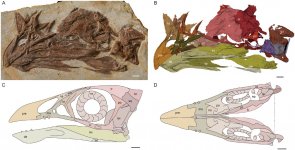Fred Ruhe
Well-known member

Han Hu, Yan Wang, Matteo Fabbri, Jingmai K. O Çonnor, Paul G. Mcdonald, Stephen Wroe, Xuwei Yin, Ziaoting Zheng, Zhonghe Zhou, Roger B. J. Benson, 2022
Cranial osteology and palaeobiology of the Early Cretaceous bird Jeholornis prima (Aves: Jeholornithiformes)
Zoological Journal of the Linnean Society. doi:10.1093/zoolinnean/zlac089
Abstract: Cranial osteology and palaeobiology of the Early Cretaceous bird Jeholornis prima (Aves: Jeholornithiformes)
Jeholornis is a representative of the earliest-diverging bird lineages, providing important evidence of anatomical transitions involved in bird origins. Although ~100 specimens have been reported, its cranial morphology remains poorly documented owing to poor two-dimensional preservation, limiting our understanding of the morphology and ecology of the key avian lineage Jeholornithiformes, in addition to cranial evolution during the origin and early evolution of birds. Here, we provide a detailed description of the cranial osteology of Jeholornis prima, based primarily on high-quality, three-dimensional data of a recently reported specimen. New anatomical information confirms the overall plesiomorphic morphology of the skull, with the exception of the more specialized rostrum. Data from a large sample size of specimens reveal the dental formula of J. prima to be 0–2–3 (premaxillary–maxillary–dentary tooth counts), contrary to previous suggestions that the presence of maxillary teeth is diagnostic of a separate species, Jeholornis palmapenis. We also present evidence of sensory adaptation, including relatively large olfactory bulbs in comparison to other known stem birds, suggesting that olfaction was an important aspect of Jeholornis ecology. The digitally reconstructed scleral ring suggests a strongly diurnal habit, supporting the hypothesis that early-diverging birds were predominantly active during the day.
Enjoy,
Fred
Cranial osteology and palaeobiology of the Early Cretaceous bird Jeholornis prima (Aves: Jeholornithiformes)
Zoological Journal of the Linnean Society. doi:10.1093/zoolinnean/zlac089
Abstract: Cranial osteology and palaeobiology of the Early Cretaceous bird Jeholornis prima (Aves: Jeholornithiformes)
Jeholornis is a representative of the earliest-diverging bird lineages, providing important evidence of anatomical transitions involved in bird origins. Although ~100 specimens have been reported, its cranial morphology remains poorly documented owing to poor two-dimensional preservation, limiting our understanding of the morphology and ecology of the key avian lineage Jeholornithiformes, in addition to cranial evolution during the origin and early evolution of birds. Here, we provide a detailed description of the cranial osteology of Jeholornis prima, based primarily on high-quality, three-dimensional data of a recently reported specimen. New anatomical information confirms the overall plesiomorphic morphology of the skull, with the exception of the more specialized rostrum. Data from a large sample size of specimens reveal the dental formula of J. prima to be 0–2–3 (premaxillary–maxillary–dentary tooth counts), contrary to previous suggestions that the presence of maxillary teeth is diagnostic of a separate species, Jeholornis palmapenis. We also present evidence of sensory adaptation, including relatively large olfactory bulbs in comparison to other known stem birds, suggesting that olfaction was an important aspect of Jeholornis ecology. The digitally reconstructed scleral ring suggests a strongly diurnal habit, supporting the hypothesis that early-diverging birds were predominantly active during the day.
Enjoy,
Fred
Last edited:





